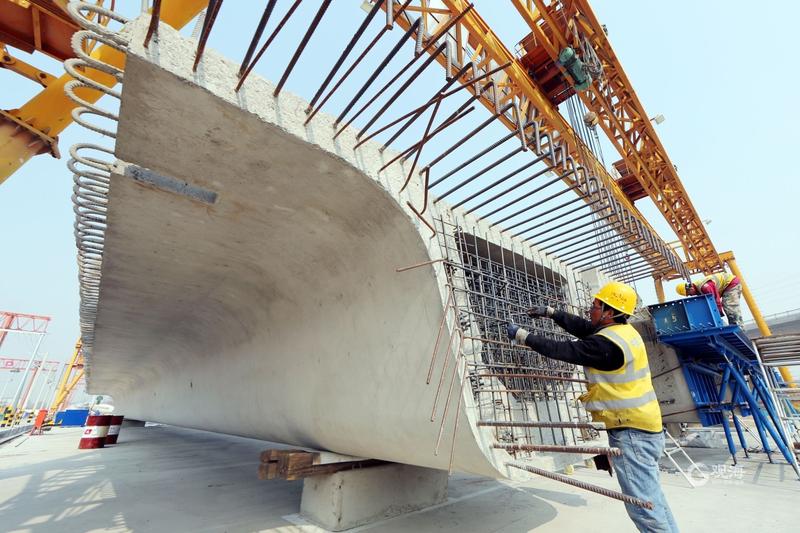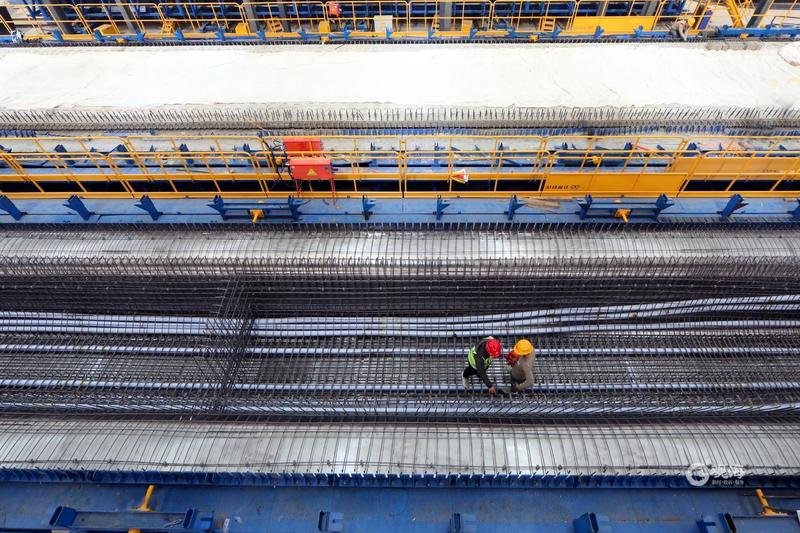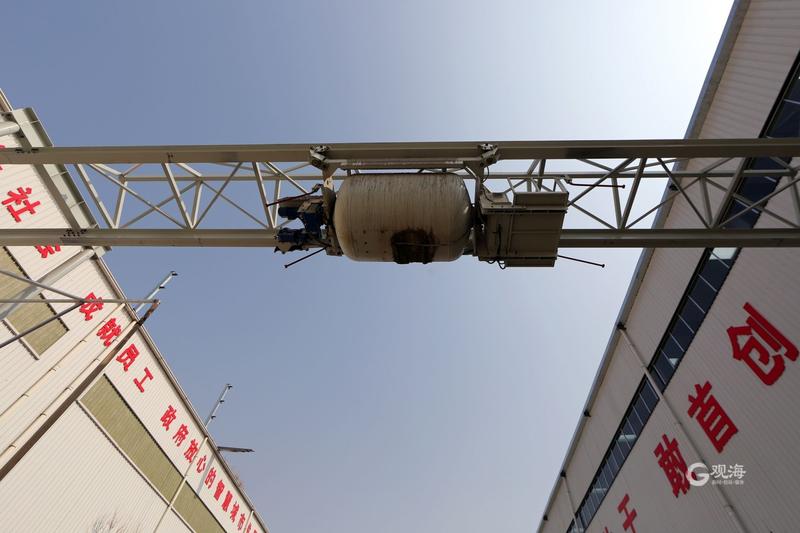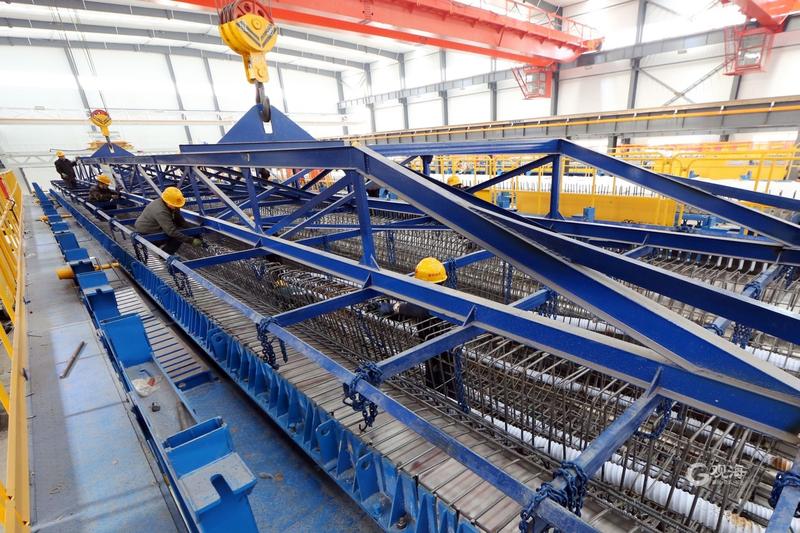A 100-ton box girder, sitting on a "small train" and living in a "steam room".. This is the scene that the reporter saw in the workshop of Qingdao Chengtie Intelligent Construction Technology Co., Ltd., located on Xinye Road, High-tech Zone, on the morning of 8th. Urban renewal and urban construction are in full swing. Last year, six key projects to alleviate regional traffic congestion, including Tanghe Road, Anshun Road and Liaoyang Road Expressway, were opened to traffic, marking that the main line of Qingdao Municipal Road Construction has become the standard mode for one year, breaking through the previous construction period. The problems of blocking points, difficulties and pain points for citizens to travel are being solved efficiently. One of the important reasons for the efficient promotion of "Qingdao Speed" and "Qingdao Standard" is that the components and accessories are processed in the factory and assembled on the construction site. On the morning of the 8th, the reporter visited the largest prefabricated component production base in the city, revealing the technology behind the "building blocks" of road and bridge construction.
Urban elevated "spell" to build
"thump, thump, thump.." On the morning of the 8th, walking into the workshop located in Xinye Road, High-tech Zone, with the rhythmic sound of machinery, a cabin of concrete sat on a "small train" and slowly entered the box girder production workshop from the mixing workshop. After pouring down the concrete, he drove back slowly along the track. "This concrete cabin is called'torpedo tank ', from the mixing workshop to the beam mould pouring concrete, the whole process has been intellectualized." Zhou Peng, the technical director of the 25th Bureau of China Railway, told reporters that a viaduct, in addition to pavement engineering, has three important components from top to bottom: box girder, capping beam and pier column.

The workers are prefabricating the box girder.
"In the past, a box girder was prefabricated in the beam yard, and the four processes of binding steel bars, pouring concrete, curing and tensioning were carried out in situ.". Each beam needs to occupy a station for at least 10 days. Now with the intelligent production line, the efficiency has been greatly improved. Reporters at the beam making site saw that eight rails about 300 meters long were arranged in parallel in the factory area. The workshop on one side of the rail is the steel bar binding area, and the other side is the steam curing area. Each box girder occupies a station on the rail. After completing a process, the hollow box girder weighing more than 200 tons will move to the next work area with the workstation like a "small train".

The workers are binding the steel bars. The small train that the
reporter saw when he entered the factory was a "cloud track" with a high degree of automation. Every few minutes, a "torpedo tank" slowly moves sideways from the mixing station next door to pour concrete into the lower beam mould. Zhou Peng said that in the pipeline operation, each process is closely connected, speeding up and increasing efficiency. A box girder can be offline in 5 days, and the work efficiency is obviously improved compared with the traditional process.

Torpedo can sit on the cloud track. A "steam curing room"
is built
on site. During the pouring of beams and slabs, the concrete needs to be vibrated and tamped to make the material more dense, so as to improve the strength of beams and slabs and ensure the quality. "In the production line of the intelligent beam yard, we adopt the intelligent high-frequency vibration method, and the concrete is automatically controlled remotely from entering the mould to forming." Workers only need to set vibration frequency, vibration duration and other parameters in the equipment control system to intelligently control the vibration operation. This process avoids the uneven or excessive vibration of manual vibration, effectively solves the problems of concrete easy to leave gaps, bubbles, separation of sand and cement, and improves the quality of prefabricated components. The curing of
beam and slab components is a key link after concrete pouring. After constant temperature steam curing, the strength of concrete increases rapidly, which can make the components reach the design standard strength as soon as possible. Traditional health preservation process is mainly carried out outdoors, and the temperature is controlled by artificial sprinkling, which is affected by temperature and other factors to a certain extent. In this beam yard, the circular production line adopts the steam curing process. The prefabricated components go through the steps of heating, constant temperature and cooling in the environment of 45 ℃ -50 ℃ in the steam curing shed, which intelligently creates the best conditions for curing, and can reach the design strength faster. The curing time of a beam is greatly shortened compared with the traditional way.
Zhou Peng introduced that the project covers an area of 133 mu, including intelligent prefabricated box girder production line, steel bar intelligent processing center, automatic concrete ready-mixed center and other production areas, mainly engaged in assembly municipal, transportation, housing construction new materials production and other business. The beam yard production line has changed the extensive management mode in the past, and the main processes can be carried out in a fully enclosed workshop, which overcomes the shortcomings of the traditional mode, such as long production cycle, large floor area, and vulnerable to weather and environment. Steel bar is the key to reduce half
of the
construction time for box girder production. In the steel bar intelligent processing center, more than 10 devices perform their duties, only to see a robot waving a mechanical arm, "grabbing" a steel bar and bending it into various shapes, while the other side of the machine quickly and accurately cuts, bends and transports the steel bar. The process is complex and the production task is heavy, but with the help of intelligent machines, the amount of labor does not rise but falls. "We just need to input the parameters on the touch screen, click the open button, and it only takes 3 seconds to bend and shape according to the customized graphics, and it can achieve high-precision control of plus or minus 1 mm." The prefabricated component factory is a diversified production base integrating scientific and technological research and development, prefabricated component production, construction and assembly, and batch processing of finished steel products. It has batch research and development and production capacity, and the daily production capacity of finished steel products can reach more than 100 tons.

The rebar is hoisted onto the bearing platform. Components and accessories are processed
in the factory and assembled on the construction site, which is more efficient and environmentally friendly, and is becoming a new representative of the industry. "We prefabricate box girders, pipe galleries and other components in the factory, and then transport them to the site for assembly, just like building blocks." Zhou Peng compared the factory to the production base of "Engineering Lego" in Qingdao. "Assembly construction is adopted, and when the site is still doing pile foundation construction, the rear beam yard will synchronously produce road and bridge components.". The foundation is ready and the components are pulled to the site to achieve seamless docking. According to the calculation, in the face of the same amount of work, the scope of temporary road occupation on site is significantly reduced and the duration of road occupation is reduced by half. "Urban roads are busy and crowded, and the area and duration of temporary construction are a race against time." Song Kekun, the chief engineer of the Eighth Bureau of China Construction, who was responsible for the construction of Liaoyang Road Expressway, has already experienced the benefits of assembly production. Last year, the work area it was responsible for needed 200 box girders, while Liaoyang Road was the main road of urban traffic, and on-site pouring needed to occupy the road, which had a greater impact on traffic. Through prefabrication in advance, the box girder was erected on the bridge while the road traffic was small late at night, which effectively guaranteed the construction period of the project. On December 26,
last year, through one year's unremitting efforts, six key projects to alleviate regional traffic congestion, such as Tanghe Road-Anshun Road and Liaoyang Road Expressway, were opened to traffic, marking that the one-year main line of Qingdao municipal road construction has become a standard mode, and the construction of Qingdao municipal roads has become a standard mode. It has broken through the constraints of long construction period, slow progress and great impact on citizens'travel in the past, and the problems of blocking points, difficulties and pain points of citizens' travel are being solved efficiently. This year is a key year for the three-year campaign of urban renewal and urban construction, and major projects such as Chongqing Road Expressway are steadily advancing.
"Since we built the first prefabricated component factory in 2019, we have provided more than 1300 box girders, which has effectively guaranteed the smooth progress of Qingdao's three-year urban construction and urban renewal campaign, and provided strong support for Qingdao's speed and Qingdao's model." Zhou Peng said that the company had previously undertaken the production and installation of prefabricated components for many key projects, such as Qingdao New Airport High-speed Connection Line and Qingdao Liaoyang Road Traffic Construction Project, to promote the high-quality development of the city's prefabricated construction industry. The first prefabricated component factory has not been in operation for a long time, but two first cases have been born. "One is the widest and heaviest integral large-section underground prefabricated comprehensive pipe gallery in Shandong Province, and the other is the first 25-centimeter-wide artificial stone-like concrete curb in China." The 1048 prefabricated pipe galleries used in the underground pipe gallery construction of Tanghe Road-Anshun Road Opening Project are also produced by them. The three-year campaign of
urban renewal and urban construction has been carried out in an orderly manner, and the company's production tasks are also facing a test. In order to ensure demand, all 14 production lines of the company will operate at full capacity, and workers will work in two shifts for 24 hours without interruption. After the project has the conditions for erection, the prefabricated box girder will be carried to the project site by a large gun truck with nearly 100 wheels, and then erected on the bridge by a crawler crane and other equipment.



 浙公网安备33010802003254号
浙公网安备33010802003254号